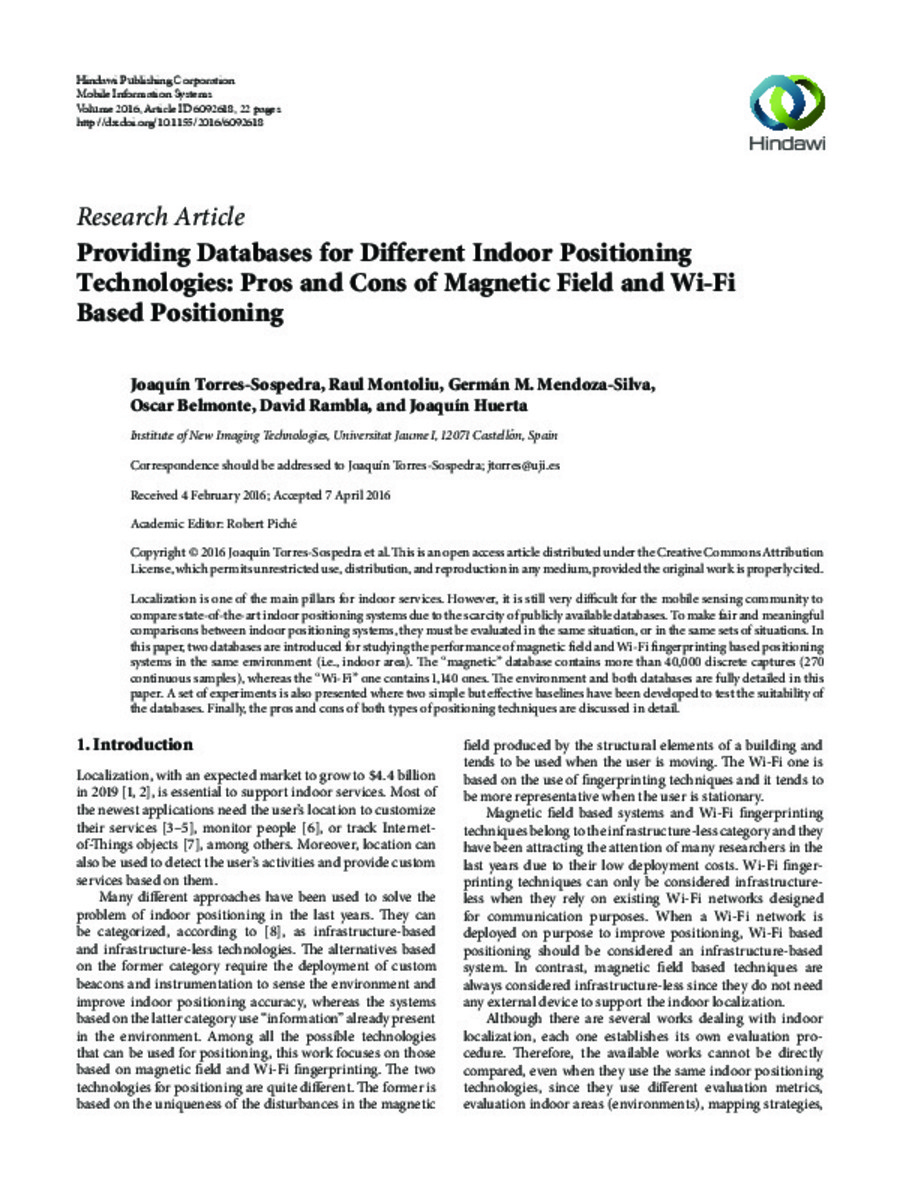Mostrar el registro sencillo del ítem
Providing Databases for Different Indoor Positioning Technologies: Pros and Cons of Magnetic Field and Wi-Fi Based Positioning
| dc.contributor.author | Torres-Sospedra, Joaquín | |
| dc.contributor.author | Montoliu Colás, Raul | |
| dc.contributor.author | Mendoza-Silva, Germán Martín | |
| dc.contributor.author | Belmonte-Fernández, Óscar | |
| dc.contributor.author | Rambla Risueño, David | |
| dc.contributor.author | Huerta, Joaquin | |
| dc.date.accessioned | 2016-10-17T10:26:10Z | |
| dc.date.available | 2016-10-17T10:26:10Z | |
| dc.date.issued | 2016 | |
| dc.identifier.citation | TORRES-SOSPEDRA, Joaquín, et al. Providing Databases for Different Indoor Positioning Technologies: Pros and Cons of Magnetic field and Wi-Fi based Positioning. | ca_CA |
| dc.identifier.issn | 1574-017X | |
| dc.identifier.uri | http://hdl.handle.net/10234/163622 | |
| dc.description.abstract | Localization is one of the main pillars for indoor services. However, it is still very difficult for the mobile sensing community to compare state-of-the-art indoor positioning systems due to the scarcity of publicly available databases. To make fair and meaningful comparisons between indoor positioning systems, they must be evaluated in the same situation, or in the same sets of situations. In this paper, two databases are introduced for studying the performance of magnetic field and Wi-Fi fingerprinting based positioning systems in the same environment (i.e., indoor area). The “magnetic” database contains more than 40,000 discrete captures (270 continuous samples), whereas the “Wi-Fi” one contains 1,140 ones. The environment and both databases are fully detailed in this paper. A set of experiments is also presented where two simple but effective baselines have been developed to test the suitability of the databases. Finally, the pros and cons of both types of positioning techniques are discussed in detail. | ca_CA |
| dc.description.sponsorShip | The authors gratefully acknowledge funding from the European Union through the GEO-C project (H2020-MSCA-ITN- 2014, Grant Agreement no. 642332, http://www.geo-c.eu/). The authors also gratefully acknowledge funding from the Spanish Ministry of Economy and Competitiveness through the “Metodolog´ıas avanzadas para el diseno, desarrollo, eval- ˜ uacion e integraci ´ on de algoritmos de localizaci ´ on en inte- ´ riores” project (Proyectos I+D Excelencia, codigo TIN2015- ´ 70202-P) and the “Red de Posicionamiento y Navegacion en ´ Interiores” network (Redes de Excelencia, codigo TEC2015- ´ 71426-REDT). The authors would like to thank all the current and past members of the Geospatial Technologies Research Group and Ubik Geospatial Solutions S.L. for their valuable help in creating the SmartUJI platform and providing us with the supporting services that allowed integrating the existing GIS services in the applications developed to create both databases. | ca_CA |
| dc.format.extent | 23 p. | ca_CA |
| dc.format.mimetype | application/pdf | ca_CA |
| dc.language.iso | eng | ca_CA |
| dc.publisher | Hindawi Publishing Corporation | ca_CA |
| dc.publisher | IOS Press | ca_CA |
| dc.relation.isPartOf | Mobile Information Systems, 2016 | ca_CA |
| dc.rights | Copyright © 2016 Joaquin Torres-Sospedra et al.This is an open access article distributed under the Creative Commons Attribution License, which permits unrestricted use, distribution, and reproduction in any medium, provided the original work is properly cited. | ca_CA |
| dc.rights.uri | http://rightsstatements.org/vocab/InC/1.0/ | * |
| dc.subject | Database systems | ca_CA |
| dc.subject | Magnetic fields | ca_CA |
| dc.subject | Magnetism | ca_CA |
| dc.subject | Wireless local area networks (WLAN) | ca_CA |
| dc.subject | Indoor positioning | ca_CA |
| dc.subject | Mobile sensing | ca_CA |
| dc.subject | Positioning techniques | ca_CA |
| dc.subject | State of the art | ca_CA |
| dc.subject | Wi-Fi fingerprinting | ca_CA |
| dc.title | Providing Databases for Different Indoor Positioning Technologies: Pros and Cons of Magnetic Field and Wi-Fi Based Positioning | ca_CA |
| dc.type | info:eu-repo/semantics/article | ca_CA |
| dc.identifier.doi | http://dx.doi.org/10.1155/2016/6092618 | |
| dc.rights.accessRights | info:eu-repo/semantics/openAccess | ca_CA |
| dc.relation.publisherVersion | http://www.iospress.nl/journal/mobile-information-systems/ | ca_CA |
| dc.type.version | info:eu-repo/semantics/publishedVersion | ca_CA |
Ficheros en el ítem
Este ítem aparece en la(s) siguiente(s) colección(ones)
-
INIT_Articles [742]







